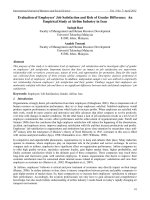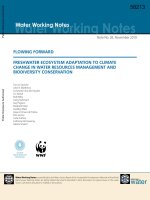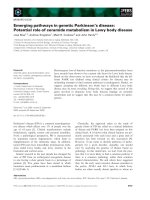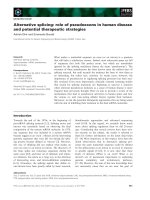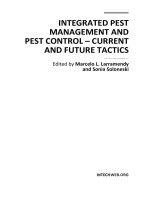role of plant growth-promoting rhizobacteria in integrated disease management and productivity of tomato
Bạn đang xem bản rút gọn của tài liệu. Xem và tải ngay bản đầy đủ của tài liệu tại đây (4.78 MB, 266 trang )
ROLE OF PLANT GROWTH-PROMOTING RHIZOBACTERIA IN INTEGRATED
DISEASE MANAGEMENT AND PRODUCTIVITY OF TOMATO
DISSERTATION
Presented in Partial Fulfillment of the Requirements for
the Degree Doctor of Philosophy in the Graduate
School of the Ohio State University
By
Cristian Nava Diaz, M.S.
* * *
The Ohio State University
2006
Dissertation Committee:
Ph.D. Sally A. Miller, Adviser _______________________
Ph.D. Michael A. Ellis
Ph.D. Matthew D. Kleinhenz
Ph.D. Douglas J. Doohan
UMI Number: 3197883
3197883
2006
UMI Microform
Copyright
All rights reserved. This microform edition is protected against
unauthorized copying under Title 17, United States Code.
ProQuest Information and Learning Company
300 North Zeeb Road
P.O. Box 1346
Ann Arbor, MI 48106-1346
by ProQuest Information and Learning Company.
ii
ABSTRACT
The ability of three rifampicin-resistant strains of Bacillus spp. (B. subtilis MI600,
B. subtilis GBO3 and B. amyloliquefaciens IN937) to improve fresh market
tomato growth and productivity and reduce the intensity of diseases caused by
Xanthomonas euvesicatoria, Alternaria solani, Septoria lycopersici and
Pseudomonas cichorii was evaluated under greenhouse, field, and controlled
environmental conditions. Rifampicin-resistant mutants of each strain were
generated and used to monitor colonization of tomato roots. There were no
differences in colony morphology, endospore production or ERIC fingerprint
pattern between wild-type and rifampicin resistant mutants of MBI600 and IN937.
The rifampicin-resistant mutant of GBO3 had the same colony morphology and
ERIC-fingerprint pattern as the wild-type, but produced significantly fewer
endospores. Under greenhouse conditions, no growth increase or bacterial leaf
spot (X. euvesicatoria) suppression was observed in tomato plants inoculated
with any of the Bacillus spp. evaluated in this study. Under field conditions,
MBI600 and GB03+IN937 were integrated in an intensive tomato management
program that included mulch, drip irrigation and a forecasted fungicide spray
program. Bacillus spp. population densities were 10
4
- 10
6
CFU g
-1
during the
iii
seedling stage and dropped to less than 10
3
CFU g
-1
during the flowering and
fruiting stages. Significant increases in plant height were observed in all Bacillus-
inoculated tomato plants, however, foliar diseases incited by A. solani and S.
lycopersici were not reduced. GBO3+IN937-inoculated plants were more
susceptible to bacterial stem rot caused by Pseudomonas cichorii than those
inoculated with MBI600 or non-inoculated control plants. In controlled
environmental studies, Bacillus spp. population densities ranged from 10
1
-10
5
CFU g
-1
tomato root. Neither nitrogen concentration in the nutrient solution nor
activation of the systemic acquired resistance defense mechanism had a
significant effect on population density of MBI600, GBO3 or IN937. In a separate
experiment under controlled environmental conditions, Bacillus spp. strains
MBI600, and GBO3+IN937 did not increase nitrogen concentration in tomato
leaves. Lesions induced by Pseudomonas cichorii on tomato stems tended to be
longer in GBO3+IN937 inoculated plants than those inoculated with MBI600 or a
water-treated control.
iv
DEDICATION
To my parents
Maria Cristina Diaz Lozano
Jose Guadalupe Nava Bernal
reri
v
ACKNOWLEDGMENTS
The author would like to express his deepest gratitude to all members of his
advisory committee, Dr. Sally A. Miller, Dr. Michael A. Ellis, Dr. Douglas J.
Doohan, and Dr. Matthew D. Kleinhenz for their various inputs during course and
laboratory work as well as guidance in this research.
The author would like to thank Ms. Melanie L. Lewis Ivey and Dr. Annette L.
Wszelaki for their important inputs and guidance during his stay at The Ohio
State University Department of Plant Pathology.
The author would like to acknowledge the economical support of the National
Council for Science and Technology (CONACyT) Mexico and the Ohio State
University
The author would like to acknowledge Mr. Bert Bishop, Dr. Larry Madden, and
Dr. Paul Pierce for patient support in statistical analysis.
The author would like to acknowledge the support of Dr. Fulya Baysal Tustas.
The author would like to thank the help and support of Emilia Gabriela Briceno
Montero.
The author acknowledges the support of Fatthy and Samia Abdelalim.
The author acknowledges the support of friends: Katia A. Figueroa R., Mizuho
Nita, Angel Rebollar Alviter, Jhony Mera, Carilyn Perry and Santiago X. Mideros.
vi
VITAE
1971………….…Born, Mexico city
1994………….…Research Assistant, Phytopathogenic Fungi
1995………… BSc Agricultural Parasitology, Autonomous Chapingo University
1997………… M.S. Phytopathology, Postgraduate College
1997…………… Technician, Plant Parasitic Nematodes
2001………….…Research Assistant, Integrated Disease Management
2002 – present…Student Research Assistant, The Ohio State University
PUBLICATIONS
Nava-Diaz, C., Abdelalim, F., Kleinhenz, M.D., Doohan, D.J., Lewis Ivey M.L.,
and Miller, S.A. 2005. Effect of mulch, irrigation, fungicide program and
Bacillus spp. on fresh market tomato. Phytopathology 95: s73
Lewis-Ivey, M.L., Nava-Diaz, C., and Miller, S.A. 2004. Identification and
management of Colletotrichum acutatum on immature bell peppers. Plant
Disease 88: 1198-1204
Nava-Diaz, C., Kleinhenz, M.D., Doohan, D.J., Lewis-Ivey, M.L. and Miller, S.A.
2004. Bacillus spp. with potential as biological control agents.
Phytopathology 84(6): s74
Teliz, O.D. and Nava, D.C. 2001. Integrated pest management: bases and
philosophy. 15-22 (8p.). Teliz, O. D. 2001. Integrated Pest Management.
Simposio. Annual Congress. (ISBN 968-5284-07-5). The Postgraduate
College, Mexican Entomological Society and Mexican Phytopathological
Society. Queretaro, México. July 2001: 129p
FIELDS OF STUDY
Plant Pathology
vii
TABLE OF CONTENTS
ABSTRACT ii
DEDICATION iv
ACKNOWLEDGMENTS v
VITAE vi
LIST OF TABLES ix
LIST OF FIGURES xx
LIST OF ABBREVIATIONS xxv
INTRODUCTION 1
CHAPTER 1 28
INTRODUCTION 28
MATERIALS AND METHODS 34
RESULTS 39
DISCUSSION 49
CONCLUSIONS 53
LIST OF REFERENCES 54
CHAPTER 2 60
INTRODUCTION 60
MATERIALS AND METHODS 65
RESULTS 71
DISCUSSION 91
CONCLUSIONS 97
LIST OF REFERENCES 98
CHAPTER 3 105
INTRODUCTION 105
viii
MATERIALS AND METHODS 110
RESULTS 120
DISCUSSION 142
CONCLUSIONS 147
LIST OF REFERENCES 148
CHAPTER 4 153
INTRODUCTION 153
MATERIALS AND METHODS 158
RESULTS 167
DISCUSSION 181
CONCLUSIONS 185
LIST OF REFERENCES 186
CHAPTER 5 192
INTRODUCTION 192
MATERIALS AND METHODS 197
RESULTS 206
DISCUSSION 214
CONCLUSIONS 217
LIST OF REFERENCES 218
CONCLUSIONS 220
LIST OF REFERENCES 223
ix
LIST OF TABLES
Table 1.1. Analysis of variance of endospore production by Bacillus subtilis
(MBI600 and GBO3) and B. amyloliquefaciens (IN937) on endospore-forming
medium after 14 days incubation. Means followed by the same letter are not
significantly different (LSD 0.05) 42
Table 1.2. Mathematical models that best describe Bacillus subtilis (MBI600 and
GBO3) and B. amyloliquefaciens (IN937) endospore formation over time. 46
Table 2.1. Composition of nutrient solution used to fertilize tomato seedlings. 67
Table 2.2. Bacterial population composition in 49 day-old tomato roots inoculated
with Bacillus subtilis strain MBI600, B. subtilis strain GBO3 and B.
amyloliquefaciens strain IN937. Colonies were isolated from roots on rifampicin-
amended medium. Identification was based on colony morphology and rep-PCR
with ERIC primers carried out on three colonies per sample (Experiment I). 74
Table 2.3. Analysis of variance of Bacillus subtilis strain MBI600, B. subtilis strain
GBO3 and B. amyloliquefaciens strain IN937 population densities on 49 day-old
tomato roots. Colonies were isolated from roots on rifampicin-amended medium.
Identification was based on colony morphology and rep-PCR with ERIC primers
carried out on three colonies per sample (Experiment I). Barlett’s p-value 1.0.
Normality assumed 74
x
Table 2.4. Bacterial population composition on 56 day-old tomato roots
inoculated with Bacillus subtilis strain MBI600, B. subtilis strain GBO3 and B.
amyloliquefaciens strain IN937. Colonies were isolated from roots on rifampicin-
amended medium. Identification was based on colony morphology and rep-PCR
with ERIC primers carried out on three colonies per sample (Experiment II). 75
Table 2.5. Analysis of variance of Bacillus subtilis strain MBI600, B. subtilis strain
GBO3 and B. amyloliquefaciens strain IN937 population densities on 56 day-old
tomato roots. Colonies were isolated from roots on rifampicin-amended medium.
Identification was based on colony morphology and rep-PCR with ERIC primers
carried out on three colonies per sample (Experiment II). Barlett’s p-value 1.0.
Normality assumed 75
Table 2.6 Growth promotion and induced resistance against Xanthomonas
euvesicatoria in three varieties of tomato inoculated with rifampicin-resistant
mutants of Bacillus subtilis strain MBI600, B. subtilis strain GBO3 and B.
amyloliquefaciens strain IN937 under greenhouse conditions (Experiment I).
Plant height was evaluated over time. The area under the plant height curve was
used for statistical analysis. Root length, fresh weight, dry weight and bacterial
leaf spot were evaluated at the end of the experiment. Tomato varieties
‘Mountain Fresh’ and ‘Mountain Spring’ are abbreviated as ‘Mfresh’ and
‘Mspring’, respectively. Inoculation and non inoculation with X. euvesicatoria are
xi
abbreviated as ‘xc’ and ‘xo’, respectively. Levene’s p-values were 0.493, 0.359,
0.063, 0.032, and 0.000 for plant height, root length, fresh weight, dry weight and
bacterial leaf spot density, respectively. Normality was assumed. 80
Table 2.7 Growth promotion and induced resistance against Xanthomonas
euvesicatoria on four varieties of tomato inoculated with rifampicin-resistant
mutants of Bacillus subtilis strain MBI600, B. subtilis strain GBO3 and B.
amyloliquefaciens strain IN937 under greenhouse conditions (Experiment II).
Plant height was evaluated over time. The area under the plant height curve was
used for statistical analysis. Root length, fresh weight, dry weight and bacterial
leaf spot were evaluated at the end of the experiment. Tomato varieties
‘Mountain Fresh’ and ‘Mountain Spring’ are abbreviated as ‘Mfresh’ and
‘Mspring’, respectively. Inoculation and non inoculation with X. euvesicatoria are
abbreviated as ‘xc’ and ‘xo’, respectively. Levene’s p-values were 1.000, 0.504,
0.169, 0.045, and 0.009 for plant height, root length, fresh weight, dry weight and
bacterial leaf spot density, respectively. Normality was assumed. 85
Table 3.1. Bacterial population composition on tomato roots inoculated with
Bacillus subtilis strain MBI600, B. subtilis strain GBO3 and B. amyloliquefaciens
strain IN937. Colonies were isolated from roots on rifampicin-amended medium.
Identification was based on colony morphology and rep-PCR with ERIC primers
carried out on three colonies per sample. Seedling (29 day old), vegetative (49
xii
day old), flowering (102 day old) and fruiting (132 day old) stages (Experiment I).
123
Table 3.2. Bacterial population composition in tomato roots inoculated with
Bacillus subtilis strain MBI600, B. subtilis strain GBO3 and B. amyloliquefaciens
strain IN937. Colonies were isolated from roots on rifampicin-amended medium.
Identification was based on colony morphology and rep-PCR with ERIC primers
carried out on three colonies per sample. Seedling (36 day old), vegetative (60
day old), flowering (114 day old) and fruiting (143 day old) stages (Experiment II).
124
Table 3.3. Growth promotion of ‘Mountain Spring’ tomato inoculated with
rifampicin-resistant mutants of Bacillus subtilis strain MBI600, B. subtilis strain
GBO3 and B. amyloliquefaciens strain IN937 under field conditions (Experiment
I). Plant height, number of leaves, leaf length, leaf width, nitrate concentration,
foliar fresh and dry weights and leaf area were evaluated three times, on 81, 95,
and 116 day-old plants. The area under the curve was used for statistical
analysis. Averages are shown. Irrigation, fungicide, and PGPR treatment are
abbreviated as ‘irrig’, ‘fungi’, and ‘treat’, respectively. Levene’s p-values were
0.950, 0.893, 0.996, 0.998, 0.983, 0.999, 1.000, and 0.999 for plant height,
number of leaves, leaf length, leaf width, nitrate concentration, foliar fresh and
dry weights and leaf area, respectively. Normality was assumed 131
xiii
Table 3.4. Growth promotion of ‘Mountain Spring’ tomato inoculated with
rifampicin-resistant mutants of Bacillus subtilis strain MBI600, B. subtilis strain
GBO3 and B. amyloliquefaciens strain IN937 under field conditions (Experiment
II). Plant height, number of leaves, leaf length, leaf width, nitrate concentration,
foliar fresh and dry weights and leaf area were evaluated three times on 101,
118, and 141 day-old plants. The area under the curve was used for statistical
analysis. Averages are shown. Irrigation, fungicide, and PGPR treatment are
abbreviated as ‘irrig’, ‘fungi’, and ‘treat’, respectively. Levene’s p-values were
0.926, 0.991, 0.994, 0.610, 0.999, 0.603, 0.573, and 0.879 for plant height,
number of leaves, leaf length, leaf width, nitrate concentration, foliar fresh and
dry weights and leaf area, respectively. Normality was assumed 133
Table 4.1. Composition of nutrient solutions used to fertilize tomato seedlings.
161
Table 4.2. Characteristics of Bacillus spp. inoculum suspensions drenched on 14
and 21 day-old tomato seedlings, variety ‘Mountain Spring’ (Experiment I / II).163
Table 4.3. Bacterial population composition in 49 day-old tomato roots inoculated
with rifampicin-resistant Bacillus subtilis strains MBI600, B. subtilis strain GBO3
and B. amyloliquefaciens strain IN937. Colonies were isolated from roots on
rifampicin-amended medium. Identification was based on colony morphology and
xiv
rep-PCR with ERIC primers carried out on one colony per sample (Experiments I
and II). 168
Table 4.4. Analysis of variance of rifampicin-resistant Bacillus subtilis strains
MBI600 and GBO3 and B. amyloliquefaciens strain IN937 population densities
on 49 day-old tomato roots. Colonies were isolated from roots on rifampicin-
amended medium. Identification was based on colony morphology and rep-PCR
with ERIC primers carried out on one colony per sample. Levene’s p-value were
0.814 and 0.953 for Experiment I and II, respectively. Normality was assumed.
169
Table 4.5. Analysis of variance of the effect of nitrogen concentration on
rifampicin-resistant Bacillus subtilis strains MBI600 and GBO3 and B.
amyloliquefaciens strain IN937 population densities on 49 day-old tomato roots.
Colonies were isolated from roots of on rifampicin-amended medium.
Identification was based on colony morphology and rep-PCR with ERIC primers
carried out on one colony per sample. Levene’s p-value were 0.814 and 0.953 for
Experiment I and II, respectively. Normality was assumed 169
Table 4.6. Analysis of variance of the effect of acibenzolar-S-methyl on
rifampicin-resistant Bacillus subtilis strain MBI600 and GBO3 and B.
amyloliquefaciens strain IN937 population densities on 49 day-old tomato roots.
Colonies were isolated from roots of on rifampicin-amended medium.
xv
Identification was based on colony morphology and rep-PCR with ERIC primers
carried out on one colony per sample. Levene’s p-value were 0.814 and 0.953 for
Experiment I and II, respectively. Normality was assumed 170
Table 4.7. Analysis of variance of the effect of activation of systemic aquired
resistance by acibenzolar-S-methyl before and after inoculation with rifampicin-
resistant Bacillus subtilis strains MBI600 and GBO3 and B. amyloliquefaciens
strain IN937 on bacterial population densities on 49 day-old tomato roots.
Colonies were isolated from roots of on rifampicin-amended medium.
Identification was based on colony morphology and rep-PCR with ERIC primers
carried out on one colony per sample. Levene’s p-values were 0.814 and 0.953
for Experiments I and II, respectively. Normality was assumed 171
Table 4.8. Analysis of variance of the effect of rifampicin-resistant Bacillus subtilis
strain MBI600 and GBO3 and B. amyloliquefaciens strain IN937 on nitrogen
absorption by tomato plants. Area under the curve of nitrogen concentration in
the effluent was used for statistical analysis. Averages are shown. Levene’s p-
value were 0.220 and 0.665 for Experiments I and II, respectively. Normality was
assumed 172
Table 4.9. Analysis of variance of the effect of acibenzolar-S-methyl on nitrogen
absorption by tomato plants. Area under the curve of nitrogen concentration in
the effluent was used for statistical analysis. Averages are shown. Levene’s p-
xvi
values were 0.220 and 0.665 for Experiments I and II, respectively. Normality
was assumed 173
Table 4.10. Analysis of variance of the effect of nitrogen concentration supplied
on nitrogen absorption by tomato plants. Area under the curve of nitrogen
concentration in the effluent was used for statistical analysis. Averages are
shown. Levene’s p-values were 0.220 and 0.665 for Experiments I and II,
respectively. Normality was assumed 173
Table 4.11. Analysis of variance of the effect of rifampicin-resistant Bacillus
subtilis strains MBI600 and GBO3 and B. amyloliquefaciens strain IN937 on
biomass of 49 day-old tomato plants. Area under the curve of plant height, stem
diameter and number of leaves was used for statistical analysis. Averages are
shown. Levene’s p-values for plant height, stem diameter, number of leaves, total
fresh weight, total dry weight and root length were 0.981, 0.864, 0.972, 0.414,
0.284, 0.901 (Experiment I) and 1.000, 0.961, 0.966, 0.988, 0.991, 0.982
(Experiment II), respectively. Normality was assumed. 176
Table 4.12. Analysis of variance of the effect of acibenzolar-S-methyl on biomass
of 49 day-old tomato plants. Area under the curve of plant height, stem diameter
and number of leaves was used for statistical analysis. Averages are shown.
Levene’s p-values for plant height, stem diameter, number of leaves, total fresh
weight, total dry weight and root length were 0.981, 0.864, 0.972, 0.414, 0.284,
xvii
0.901 (Experiment I) and 1.000, 0.961, 0.966, 0.988, 0.991, 0.982 (Experiment
II), respectively. Normality was assumed. 177
Table 4.13. Analysis of variance of the effect of nitrogen concentration supplied
on biomass of 49 day-old tomato plants. Area under the curve of plant height,
stem diameter and number of leaves was used for statistical analysis. Averages
are shown. Levene’s p-values for plant height, stem diameter, number of leaves,
total fresh weight, total dry weight and root length were 0.981, 0.864, 0.972,
0.414, 0.284, 0.901 (Experiment I) and 1.000, 0.961, 0.966, 0.988, 0.991, 0.982
(Experiment II), respectively. Normality was assumed. 178
Table 4.14. Analysis of variance of the effect of the interaction of nitrogen
concentration and acibenzolar-S-methyl on biomass of 49 day-old tomato plants.
Averages are shown. Levene’s p-values for total fresh weight and total dry weight
were 0.414, 0.284 (Experiment I) and 0.988, 0.991 (Experiment II), respectively.
Normality was assumed. 179
Table 4.15. Analysis of variance of the effect of the interaction of acibenzolar-S-
methyl and plant growth-promoting rhizobacteria on total fresh weight of 49 day-
old tomato seedlings. Averages are shown. Levene’s p-values for total fresh
weight were 0.414 (Experiment I) and 0.988 (Experiment II). Normality was
assumed 180
Table 5.1. Composition of nutrient solution used to fertilize tomato seedlings. 200
xviii
Table 5.2. Bacterial population composition in 60 day-old tomato roots inoculated
with rifampicin-resistant Bacillus subtilis strains MBI600, B. subtilis strain GBO3
and B. amyloliquefaciens strain IN937. Colonies were isolated from roots on
rifampicin-amended medium. Identification was based on colony morphology and
rep-PCR with ERIC primers carried out on one colony per sample (Experiment I
and II). 207
Table 5.3. Analysis of variance of rifampicin-resistant Bacillus subtilis strains
MBI600 and GBO3 and B. amyloliquefaciens strain IN937 population densities
(log CFU g
-1
root +1) on 60 day-old tomato roots. Colonies were isolated from
roots of on rifampicin-amended medium. Identification was based on colony
morphology and rep-PCR with ERIC primers carried out on one colony per
sample. Levene’s p-values were 0.635 and 0.280 for Experiment I and II,
respectively. Normality was assumed 207
Table 5.4. Analysis of variance of the effect of rifampicin-resistant Bacillus subtilis
strains MBI600 and GBO3 and B. amyloliquefaciens strain IN937 on tomato
biomass and bacterial stem rot severity. Area under the curve of plant height and
nitrogen concentration was used for statistical analysis. Averages are shown.
Levene’s p-values for plant height, root length, nitrogen in sap and lesion size
were 0.667, 0.388, 0.775, 0.023 (Experiment I) and 0.648, 0.471, 0.838, 0.045
(Experiment II), respectively. Normality was assumed. 209
xix
Table 5.5. Analysis of variance of the effect of irrigation rate on tomato biomass
and bacterial stem rot severity. Area under the curve of plant height and nitrogen
concentration was used for statistical analysis. Averages are shown. Levene’s p-
values for plant height, root length, nitrogen in sap and lesion size were 0.667,
0.388, 0.775, 0.023 (Experiment I) and 0.648, 0.471, 0.838, 0.045 (Experiment
II), respectively. Normality was assumed. 210
xx
LIST OF FIGURES
Figure 1.1. Colony morphology of Bacillus spp. on nutrient agar medium after 24
hours incubation at 28
o
C. A. B. subtilis MBI600 wild-type; B. B. subtilis MBI600
rifampicin-resistant mutant; C. B. subtilis GBO3 wild-type; D. B. subtilis GBO3
rifampicin-resistant mutant; E. B. amyloliquefaciens IN937 wild-type; F. B.
amyloliquefaciens IN937 rifampicin-resistant mutant 40
Figure 1.2. (*) Vegetative cells, (**) endospores within cell, and (***) free
endospores of Bacillus subtilis MBI600 rif on endospore-forming medium
incubated for 8 days at room temperature (945 x) 41
Figure 1.3. Production of endospores by wild-type and rifampicin-resistant strains
of Bacillus subtilis (MBI600 and GBO3) and B. amyloliquefaciens (IN937) on
endospore-forming medium incubated at room temperature under white light for
14 days. Experiment I: (+) Endospores; (∆) Rate of production of endospores;
Experiment II: (x) Endospores; (◊) Rate of production of endospores. 44
Figure 1.4. Enterobacterial repetitive intergenic consensus - polymerase chain
reaction (ERIC-PCR) products obtained from genomic DNA from Bacillus subtilis
strains MBI600 and GBO3 and B. amyloliquefaciens strain IN937. Arrows
indicate polymorphisms. 48
xxi
Figure 2.1. Chromelosporium sp. A. Conidiophore; B. Detail of conidiophores
and conidia; C. Antagonistic effect of IN937rif on a Chromelosporium spp.
colony. 73
Figure 3.1 Categories for tomato fruit assessment: A. red marketable; B. green
marketable; C. physiological disorders; D. anthracnose; E. bacterial diseases; F.
other diseases; G. insect or bird damage and H. other diseases on green fruit.
117
Figure 3.2. Identification of Bacillus subtilis strains MBI600 and GBO3 and B.
amyloliquefaciens strain IN937 isolated from 29-day old tomato roots during
seedling stage, using enterobacterial repetitive intergenic consensus -
polymerase chain reaction (ERIC-PCR) fingerprints. Wild-type and rifampicin-
resistant strain fingerprints were used as a reference. The banding patterns of
three colonies isolated from treatments (control, MBI600 and GBO3+IN937) were
compared with the reference patterns for identification (Experiment I) 125
Figure 3.3 Tomato root colonization by Bacillus spp. 29 (seedling stage), 49
(seedling stage), 102 (flowering stage) and 132 (fruiting stage) days after
seeding, Experiment I. Control plants were colonized by MBI600 (flowering and
fruiting stages), GBO3 (vegetative, flowering and fruiting stages), and IN937
(seedling, vegetative, flowering and fruiting stages). Means followed by the same
letter are not significantly different (p-value < 0.05) 126
xxii
Figure 3.4. Tomato root colonization by Bacillus spp. 36 (seedling stage), 60
(seedling stage), 114 (flowering stage) and 143 (fruiting stage) days after
seeding, Experiment II. Control plants were colonized by MBI600 (vegetative,
flowering and fruiting stages), GBO3 (fruiting stage), and IN937 (seedling and
fruiting stages). Means followed by the same letter are not significantly different.
127
Figure 3.5. Effect of irrigation on Bacillus spp. population density on 102-day-old
‘Mountain Spring’ tomato roots. Means followed by the same letter are not
significantly different (p-value < 0.05). Experiment I 128
Figure 3.6. Effect of soil drenches with rifampicin-resistant mutants of plant
growth-promoting rhizobacteria (PGPR) (Bacillus subtilis MBI600 and GBO3, and
B. amyloliquefaciens IN937) on height of ‘Mountain Spring’ tomato seedlings 49
(Experiment I) and 60 days (Experiment II) after planting. Means followed by the
same letter are not significantly different (p-value < 0.05). 135
Figure 3.7. Effect of soil drenches with rifampicin-resistant strains of plant
growth-promoting rhizobacteria (PGPR) (Bacillus subtilis MBI600 and GBO3, and
B. amyloliquefaciens IN937) on height of ‘Mountain Spring’ tomato plants under
field conditions. Plant height was evaluated on 81, 95 and 116 (Experiment I) and
101, 118, and 141 day-old plants (Experiment II). Means followed by the same
letter are not significantly different (p-value < 0.05) 136
xxiii
Figure 3.8. Effect of plastic and rye residue mulches on height of ‘Mountain
Spring’ tomato plants under field conditions. Plant height was evaluated on 81,
95 and 116 (Experiment I) and 101, 118, and 141 day-old plants (Experiment II).
Means followed by the same letter are not significantly different (p-value < 0.05).
136
Figure 3.9. Diseases and pathogens observed on ‘Mountain Spring’ tomato
plants. A. early blight; B. Alternaria solani conidia; C. septoria leaf spot; D.
pycnidia and conidia of Septoria lycopersici; E. bacterial stem rot; and F. pith
desintegration induced by Pseudomonas cichorii 138
Figure 3.10. Effect of plastic and plant residue mulches on severity of early blight
and septoria leaf spot on ‘Mountain Spring’ tomato plants under field conditions.
Severity of foliar diseases was evaluated every 7 days. Area under the disease
curve was used for statistical analysis. Means followed by the same letter are not
significantly different (p-value < 0.05) 139
Figure 3.11. Effect of plant growth-promoting rhizobacteria (PGPR) (Bacillus
subtilis MBI600 and GBO3, and B. amyloliquefaciens IN937) on bacterial stem
rot severity of ‘Mountain Spring’ tomato plants under field conditions. Severity of
bacterial stem rot was evaluated every 7 days. Area under the disease curve was
used for statistical analysis. Means followed by the same letter are not
significantly different (p-value < 0.05) 139
xxiv
Figure 3.12. Effect of plastic and plant residue mulches on severity of bacterial
stem rot on ‘Mountain Spring’ tomato plants under field conditions. Severity of
bacterial stem rot was evaluated every 7 days. Area under the disease curve was
used for statistical analysis. Means followed by the same letter are not
significantly different (p-value < 0.05) 140
Figure 3.13. Effect of plant growth-promoting rhizobacteria (PGPR) (Bacillus
subtilis MBI600 and GBO3, and B. amyloliquefaciens IN937) on marketable yield
of ‘Mountain Spring’ tomato plants. Means followed by the same letter are not
significantly different (p-value < 0.05) 141
Figure 3.14. Effect of plastic and plant residue mulches on marketable yield of
‘Mountain Spring’ tomato plants under field conditions. Means followed by the
same letter are not significantly different (p-value < 0.05). 141
Figure 4.1. Irrigation system. A. General view. B. The single line serving each pot
was situated so that solution dripped freely into the vermiculite. C. A piece of
transparent plastic covered the surface of the growing medium to reduce
evapotranspiration. 160
Figure 5.1. Bacterial stem rot (Pseudomonas cichorii). A. Brown lesions on
tomato variety ‘Mountain Spring’; B. Lesion on tomato variety ‘Big Beef’ 212

